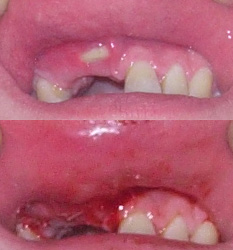Bone Spurs After Extraction

The removal of a tooth, also known as tooth extraction, is a common dental procedure that can be necessary for a variety of reasons, including severe tooth decay, gum disease, or injury. While the procedure itself is typically straightforward, there are potential complications that can arise, one of which is the development of bone spurs after extraction.
Bone spurs, also known as osteophytes, are abnormal growths of bone that can occur on the edges of bones. In the context of tooth extraction, bone spurs can form on the jawbone as it heals from the procedure. These spurs can be painful and may cause discomfort, especially if they press against the surrounding soft tissues, such as the gums, tongue, or cheek.
Why Do Bone Spurs Form After Tooth Extraction?
There are several reasons why bone spurs might form after tooth extraction:
- Healing Process: After a tooth is extracted, the body begins to heal the socket where the tooth was located. Part of this healing process involves the growth of new bone tissue to fill in the empty socket. Sometimes, this new bone growth can become excessive, leading to the formation of bone spurs.
- Inflammation: Inflammation in the extraction site can stimulate the growth of new bone tissue, which can lead to the development of bone spurs.
- Trauma: If the extraction procedure was particularly traumatic, it can cause inflammation and stimulate the growth of new bone tissue, leading to bone spurs.
- Genetic Predisposition: Some people may be more prone to developing bone spurs due to their genetic makeup.
Symptoms of Bone Spurs After Extraction
The symptoms of bone spurs after tooth extraction can vary, but common complaints include:
- Pain: Bone spurs can cause pain, especially if they press against surrounding soft tissues.
- Discomfort: Bone spurs can cause discomfort or tenderness in the extraction site.
- Swelling: The area around the bone spur may become swollen or inflamed.
- Limited Mouth Opening: In severe cases, bone spurs can limit the ability to open the mouth wide.
Diagnosis and Treatment of Bone Spurs
Diagnosing bone spurs after tooth extraction typically involves a combination of:
- Clinical Examination: A dentist or oral surgeon will examine the extraction site to look for signs of bone spurs.
- Imaging Tests: X-rays or other imaging tests may be used to confirm the presence of bone spurs.
Treatment for bone spurs after tooth extraction may involve:
- Monitoring: In some cases, bone spurs may not cause any symptoms and may not require treatment. Regular monitoring by a dentist or oral surgeon can help determine if the bone spur is causing any problems.
- Surgical Removal: If the bone spur is causing pain or discomfort, surgical removal may be necessary.
- Smoothing: In some cases, the bone spur can be smoothed down to reduce its size and alleviate symptoms.
Prevention of Bone Spurs After Extraction
While it’s not possible to completely prevent bone spurs after tooth extraction, there are steps that can be taken to reduce the risk:
- Follow Post-Extraction Instructions: Carefully following post-extraction instructions can help promote healing and reduce the risk of complications.
- Maintain Good Oral Hygiene: Keeping the mouth clean and free of bacteria can help promote healing and reduce the risk of inflammation.
- Avoid Trauma: Avoiding trauma to the extraction site, such as chewing on hard foods or using a straw, can help reduce the risk of bone spurs.
What are the symptoms of bone spurs after tooth extraction?
+The symptoms of bone spurs after tooth extraction can include pain, discomfort, swelling, and limited mouth opening.
How are bone spurs after tooth extraction diagnosed?
+Diagnosing bone spurs after tooth extraction typically involves a combination of clinical examination and imaging tests, such as X-rays.
What are the treatment options for bone spurs after tooth extraction?
+Treatment options for bone spurs after tooth extraction may include monitoring, surgical removal, or smoothing of the bone spur.
In conclusion, bone spurs after tooth extraction are a potential complication that can cause pain and discomfort. While they can be treated, it’s essential to follow post-extraction instructions carefully to minimize the risk of complications. By understanding the causes, symptoms, and treatment options for bone spurs, individuals can better navigate the healing process and reduce the risk of long-term problems.
